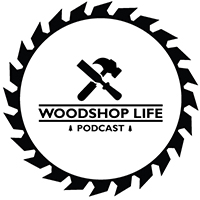This Episodes Questions:
Brians Questions:
Hi guys! Love the podcast, as always. My question for you guys this time is about design. Specifically, it’s about design based on that “special” piece of lumber. For example, I purchased a large piece of mahogany in the late 1990’s to build electric guitars. I made two guitars from it and was left with a chunk of beautiful lumber that traveled with me for the next 25 years. Two years ago, I bought a mid-sized slab of black locust. I don’t make “slab” furniture or use copious amounts of epoxy, so it’ll end up getting cut up into a project.
I know you guys normally design your projects and then buy the lumber, but have you ever bought (or acquired) that unique board and then had to design a project to do it justice? If so, what was the project? As a follow up question, what is the longest that you have ever owned a piece of lumber that you just couldn’t get rid of?
Thanks, Joshua from The Black Dog Woodworks.
I’m a new listener and your podcast has been a blast to listen to on my evening runs. I just finished a 3-year, gut-to-the-studs home renovation, and my 1 car garage was the renovation workshop. Now that the home is finished I am transitioning the shop into a proper woodworking space. During construction, I used a lot of 16D nails and 3″ construction screws and tried to have a variety of fasteners on hand so I wouldn’t be running to the hardware store 3 times a day.
This got me thinking. What are some common fasteners you like to keep in your shop? Any common screw sizes? Bolts? Washers? Nuts? Nails? Staples? It seems in woodworking shops that there’s always a balance between having so many supplies that you’ll never use most of them in 10 years to having so few supplies that you’ll be running to the store 5 times a day. What is your approach to hardware consumables? Thanks for the great podcast.
Adam
Guys Questions:
Really appreciate the podcast, i have been listening for about 18 months and am also working through your previous podcasts. I am starting the dive into spray finishing. I have previously used wipe on or brush on finishes. I like shellac, but often coat with wipe on poly for extra protection. I would picture doing the same going forward. Question: What are considerations/benefits to using a water based conversion varnish over wb poly? What type of ppe is appropriate? I have a relatively large shop which is climate controlled, not attached to house and can set up an area for finishing when needed, what type ventilation would be desirable for occasional finishing in this situation? I build furniture and smaller items.
Thanks,
David at xcuse4tools custom woodwork
Hello everyone. Love the show. Great dynamic between you all and I really enjoy the lack of ego in the question answering. Your answers are efficient, helpful and easily digestible to a beginner woodworker.
I recently acquired a Jessem Pocket Mill Pro for loose tenon joints. Like many, I had lusted after a Festool Domino but couldn’t justify the price tag for a hobby shop. The Pocket Mill Pro is a fraction of the cost and does everything I need it to do for my projects.
The workstation that pairs with the pocket mill pro can also accept Jessem’s dowel jig. My question to you all is would a dowel jig even be necessary when I have the ability to make loose tenon joints already? Is there any advantage to adding the dowl jig to my arsenal or is it a waste of money when I already have the Pocket Mill Pro?
Thanks in advance for any insight.
Jason
Huys Questions:
I’m planning on making a face grain chess board. I’ll use 3/4″ MDF as my core and glue the chess squares on top (grain from all squares facing same direction). Chess squares will be about 1/8″ thick. I assume I’ll also need to glue some 1/8″ wood on the bottom to balance out the stresses. I’ll orient the bottom grain in the same direction as the top. My question is, do I need to glue both sides at the same time, or can I glue one side, let it dry, then do the other?
Scott Goldthwait
I love to use my handplanes and can’t get over the smooth, glass-like feeling that it leaves on wood. However, many finishing manufacturers reccomend applying the finish to a surface sanded to a specific grit (e.g., Rubio reccomends applying to 120 grit, no higher). What are the advantages/disadvantages to applying finish to a sanded surface versus a hand-planed surface. I would like my handplane to be the last think that touches the wood, but I want to respect the manufactueres’ reccomendations since they obvioulsy know information I don’t (like what the ideal porosity of wood is). Thanks!
Peter Diaz
